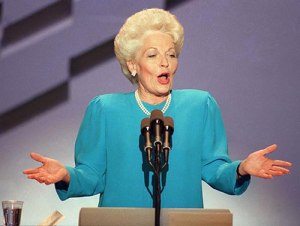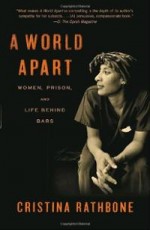When asked what she would have done differently if she’d known she was to be only a one-term governor, Ann Richards grinned and said, “I would probably have raised more hell.”
While I was at the ashram, I read Jan Reid’s Let the People In: The Life and Times of Ann Richards. I laughed with delight at the introductory chapter, and I cried with despair at the ending — at both endings. There was the end of her rather short political career in 1994, and then there was her death in 2006 from cancer.
My introduction to this bawdy, loud, wonderful lady was during her second and failed race for governor. As I wrote for my introduction when I was asked to speak during the feminist fishbowl, “Salem has identified as a feminist since 1994, when as an impressionable 16-year-old she watched Ann Richards lose her re-election bid for governor of Texas to one George W. Bush.” I remember feeling like the world was going to end that fall — and then being sure of it six years later in the fall of 2000. But here we all are.
And thank goodness for that, because the world that I live in is one that Ann Richards helped to create. As Reid notes,
Her greatest accomplishment was to bring to positions of responsibility and power in Texas the women, African Americans, Latinos, Asian Americans, gay men, lesbians, and disabled persons who had been so long denied. Because of that, state government centered in Austin will never be the same. Whatever party wins the elections and controls the appointed boards that keep the bureaucratic agencies and institutions of higher education running, democracy in Texas is better because she won.
Ann Richards was born near Waco, Texas, at the end of 1933, and she was almost immediately ill suited to her time. She was a wife (to David Richards), mother (to Cecile, Daniel, Clark, and Ellen), and teacher because that’s what women did; she was honest even in her lifetime about how those roles made her just about go out of her mind with boredom. Even when she served as chief of staff for Sarah Weddington (before the latter went to D.C. to argue Roe v. Wade before the Supreme Court), Richards had to negotiate a special arrangement with her boss to leave work early be able to cook dinner for her family. On the one hand, we should all be able to so organize our lives to spend more time with our families. On the other hand, of course Richards’ demanding job did not excuse her from her unpaid work, as it did her husband. Indeed, even as she began to field requests for appearances all over the country, Richards answered a phone call from Midge Costanza, the highest ranking woman in the Carter administration, with the breezy, “Hi, Midge, what do you want? I’m cooking David’s supper.”
Richards rose through Texas politics as a campaign volunteer, political staffer, county commissioner, state treasurer, and then governor. (Her career is a good reminder that it wasn’t so long ago that Texas was not the monolithically Republican state that it’s now considered to be.) Her spunk brought her to the attention of the national scene even when she was just a local politician, but she became a star during the 1988 Democratic National Convention in Atlanta, where she gave the keynote address. She “talked Texas” and delivered the now well-known zinger about the Republic presidential candidate: “Poor George, he can’t help it. He was born with a silver foot in his mouth.”
In 1990, Richards’s first race for governor, against millionaire businessman and good ole boy Claytie Williams, is one of the most amusingly horrifying tales in Texas history — and is chronicled brilliantly in Molly Ivins’ book Molly Ivins Can’t Say That, Can She?, a collection of the columnist’s political coverage, from which Reid draws liberally (no pun intended). Richards became the first female governor of Texas since 1924, when the wife of a former governor was elected. (They are still the only two women to have held that office.)
As Reid tells it, Richards tried to do too much: Her inauguration speech included 15 massive projects as top priorities. She made progressive headway in many, but ultimately, she would preside over the largest expansion of the criminal justice system in the country, doubling the number of incarcerated persons in Texas. In so doing, she did pioneer a revolutionary model of drug and alcohol treatment for non-violent offenders (she herself was a recovering alcoholic and drug user). And in her defense, she inherited a state prison crisis that had been broiling since the early 1970s, when an inmate brought a federal case against the state for violation of the Eighth and Fourteenth Amendments. Adding pressure to the impetus for change were several high profile killings, most notably the Luby’s massacre in Killeen in 1991 and the siege on the Branch Davidians in Waco in 1993. But the number of executions on her watch reached 48, and her only acts of clemency in four years were two 30-day stays. It is an indelible stain on her legacy that by the year 2000, Texas had the largest prison population of any Western democracy.
The book suffered slightly, not from its subject, but from its writing, which swung between not enough repetition and too much. The text was full of awkward segues that didn’t properly introduce new characters, and recurring characters were not given enough context to remind the reader of his or her significance. But as the author touched on a subject and later returned to it, entire passages (as for example, on the history of prison reform in Texas) would be repeated almost verbatim.
But Reid was a friend of Richards (and his wife was in her employ for more than a decade). The reader can’t help but feel his affection for her. Oddly enough, he refers to her as “Ann” throughout; it’s hard to tell whether this is simply familiarity, but it is certainly not customary in biography.
It is indeed easy to root for Ann Richards, who said on her inauguration: “Today we have a vision of a Texas where opportunity knows no race, no gender, no color — a glimpse of what can happen in government if we simply open the doors and let the people in.”
















Well done Salem. I have had three political female role models that I have always closely identified with, have deep (if not, unhealthy, lol) affection for, and a passionate obsession to impart their legacy on people; they are Ann Richards, Molly Ivins and Hillary Clinton. The first one to touch my life was Ann, and she’s the one I probably most closely identify with. She was real and said what was on her mind. She stood for every woman in Texas who hadn’t felt like they had a voice for decades in this state and eventually she stood for women all over the country and world. Texas politics has a deep, intricately woven and colorful history. If you take Sarah Weddington, Ann Richards, Molly Ivins, and Hillary Clinton…these women go back decades and cross paths many times. I would love to see someone write a book from the collective history of these ladies…and hell throw in Debra Danburg (who by the way is still alive to tell her story) and Barbra Jordan. When I worked the Hillary campaign I met more ladies here in the Houston area who practiced law with Sarah and Hillary and therefore also knew Ann and Barbra. It’s truly amazing how small the circle is in politics for women and how close they become. Sadder still, is that outside Texas, few know how big a role Ann played in politics in general. It’s coming though…the Broadway play, the movies…it’ll happen. And when it does, I’ll be there. My heart broke when Ann and Molly died and that they wouldn’t be able to see their friend Hillary run and be along side her campaigning. Sad.
Kim, those three women are my political role models, too! Love them all. I’ve read Hillary’s book, and coming up soon on my reading list is a biography of Molly Ivins, which this book certainly whet my appetite for. And Barbara Jordan obviously did play a role in Richards’ life, although the book reports it not as positively as I would have thought. I would definitely read the book you’d like to see written: Maybe you should write it? 😉